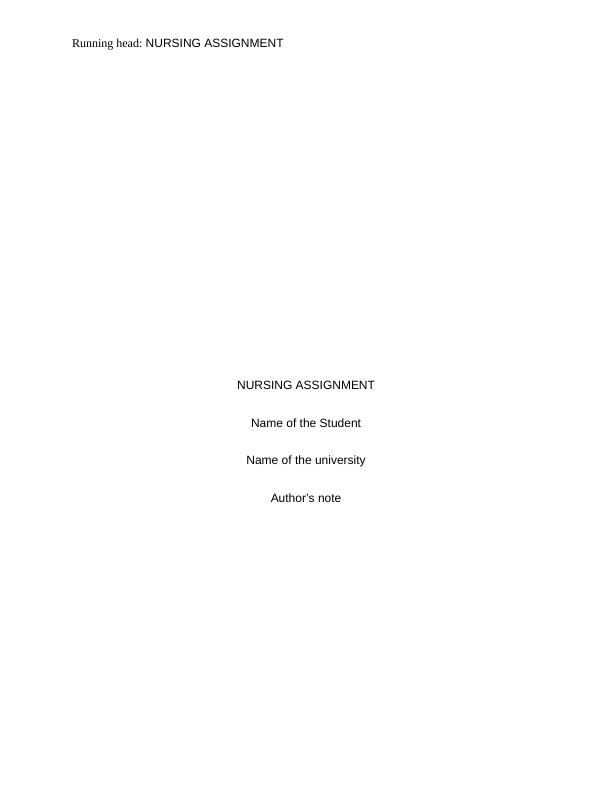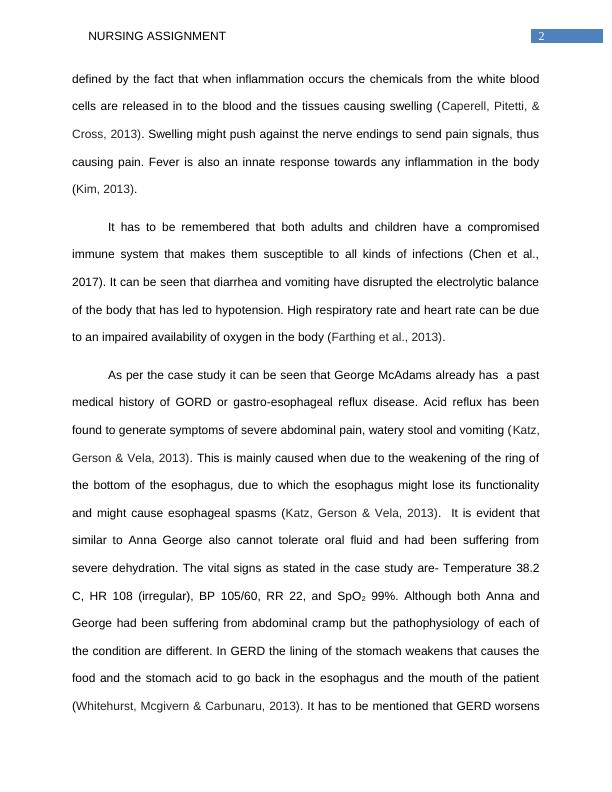Nursing Assignment: Developmental Similarities and Differences in Clinical Conditions
Added on 2023-06-03
10 Pages2446 Words174 Views
Running head: NURSING ASSIGNMENT
NURSING ASSIGNMENT
Name of the Student
Name of the university
Author’s note
NURSING ASSIGNMENT
Name of the Student
Name of the university
Author’s note

1NURSING ASSIGNMENT
Introduction
This assignment will discuss about the developmental similarities and the
differences between Anna and George, with two different clinical conditions but
pertaining to somewhat similar symptoms like diarrhea, vomiting, fluid intolerance and
abdominal cramping. Anna is a 4 years old girl who has been admitted to the ED with
the symptoms of Gastroenteritis and the George who is 86 years old and had a medical
history of gastro esophageal reflux. After the comparison of the pathophysiology of both
the conditions SMART goals has been chosen depending upon which the nursing
interventions have been developed.
Priority health problems
The clinical issue that had been chosen for this case is abdominal cramping
experienced by both Anna and George. Anna has been reported to be administered
with paracetamol and oral syrup, yet her abdominal discomfort and cramping has not
been resorted. Her pain score states that she is experiencing moderate to severe pain
and might upgrade to severe if appropriate actions are not taken (Chen et al., 2014).
Her vital signs indicated temperature 38.2 0 C, BP 88/50, HR 118, R 22, SpO2 98% .
The case study reveals that Anna is drowsy and cries when woken, which might be due
to her consciousness against pain. It has to be remembered that abdominal cramping,
watery stool and severe dehydration are the common clinical manifestations of viral
gastroenteritis (Chen et al., 2017). Fever in gastroenteritis is due to the inflammation in
the stomach (Dalby-Payne & Elliott, 2011). Pain due to inflammation in stomach can be
Introduction
This assignment will discuss about the developmental similarities and the
differences between Anna and George, with two different clinical conditions but
pertaining to somewhat similar symptoms like diarrhea, vomiting, fluid intolerance and
abdominal cramping. Anna is a 4 years old girl who has been admitted to the ED with
the symptoms of Gastroenteritis and the George who is 86 years old and had a medical
history of gastro esophageal reflux. After the comparison of the pathophysiology of both
the conditions SMART goals has been chosen depending upon which the nursing
interventions have been developed.
Priority health problems
The clinical issue that had been chosen for this case is abdominal cramping
experienced by both Anna and George. Anna has been reported to be administered
with paracetamol and oral syrup, yet her abdominal discomfort and cramping has not
been resorted. Her pain score states that she is experiencing moderate to severe pain
and might upgrade to severe if appropriate actions are not taken (Chen et al., 2014).
Her vital signs indicated temperature 38.2 0 C, BP 88/50, HR 118, R 22, SpO2 98% .
The case study reveals that Anna is drowsy and cries when woken, which might be due
to her consciousness against pain. It has to be remembered that abdominal cramping,
watery stool and severe dehydration are the common clinical manifestations of viral
gastroenteritis (Chen et al., 2017). Fever in gastroenteritis is due to the inflammation in
the stomach (Dalby-Payne & Elliott, 2011). Pain due to inflammation in stomach can be

2NURSING ASSIGNMENT
defined by the fact that when inflammation occurs the chemicals from the white blood
cells are released in to the blood and the tissues causing swelling (Caperell, Pitetti, &
Cross, 2013). Swelling might push against the nerve endings to send pain signals, thus
causing pain. Fever is also an innate response towards any inflammation in the body
(Kim, 2013).
It has to be remembered that both adults and children have a compromised
immune system that makes them susceptible to all kinds of infections (Chen et al.,
2017). It can be seen that diarrhea and vomiting have disrupted the electrolytic balance
of the body that has led to hypotension. High respiratory rate and heart rate can be due
to an impaired availability of oxygen in the body (Farthing et al., 2013).
As per the case study it can be seen that George McAdams already has a past
medical history of GORD or gastro-esophageal reflux disease. Acid reflux has been
found to generate symptoms of severe abdominal pain, watery stool and vomiting (Katz,
Gerson & Vela, 2013). This is mainly caused when due to the weakening of the ring of
the bottom of the esophagus, due to which the esophagus might lose its functionality
and might cause esophageal spasms (Katz, Gerson & Vela, 2013). It is evident that
similar to Anna George also cannot tolerate oral fluid and had been suffering from
severe dehydration. The vital signs as stated in the case study are- Temperature 38.2
C, HR 108 (irregular), BP 105/60, RR 22, and SpO2 99%. Although both Anna and
George had been suffering from abdominal cramp but the pathophysiology of each of
the condition are different. In GERD the lining of the stomach weakens that causes the
food and the stomach acid to go back in the esophagus and the mouth of the patient
(Whitehurst, Mcgivern & Carbunaru, 2013). It has to be mentioned that GERD worsens
defined by the fact that when inflammation occurs the chemicals from the white blood
cells are released in to the blood and the tissues causing swelling (Caperell, Pitetti, &
Cross, 2013). Swelling might push against the nerve endings to send pain signals, thus
causing pain. Fever is also an innate response towards any inflammation in the body
(Kim, 2013).
It has to be remembered that both adults and children have a compromised
immune system that makes them susceptible to all kinds of infections (Chen et al.,
2017). It can be seen that diarrhea and vomiting have disrupted the electrolytic balance
of the body that has led to hypotension. High respiratory rate and heart rate can be due
to an impaired availability of oxygen in the body (Farthing et al., 2013).
As per the case study it can be seen that George McAdams already has a past
medical history of GORD or gastro-esophageal reflux disease. Acid reflux has been
found to generate symptoms of severe abdominal pain, watery stool and vomiting (Katz,
Gerson & Vela, 2013). This is mainly caused when due to the weakening of the ring of
the bottom of the esophagus, due to which the esophagus might lose its functionality
and might cause esophageal spasms (Katz, Gerson & Vela, 2013). It is evident that
similar to Anna George also cannot tolerate oral fluid and had been suffering from
severe dehydration. The vital signs as stated in the case study are- Temperature 38.2
C, HR 108 (irregular), BP 105/60, RR 22, and SpO2 99%. Although both Anna and
George had been suffering from abdominal cramp but the pathophysiology of each of
the condition are different. In GERD the lining of the stomach weakens that causes the
food and the stomach acid to go back in the esophagus and the mouth of the patient
(Whitehurst, Mcgivern & Carbunaru, 2013). It has to be mentioned that GERD worsens

End of preview
Want to access all the pages? Upload your documents or become a member.
Related Documents
Integrated Nursing Practice: Pain Management Comparison and Interventionlg...
|10
|2823
|300
Clinical Scenarios: Gastroenteritis, Multiple Sclerosis, Parkinson's Disease, Osteoarthritis, and Morelg...
|13
|1783
|159
